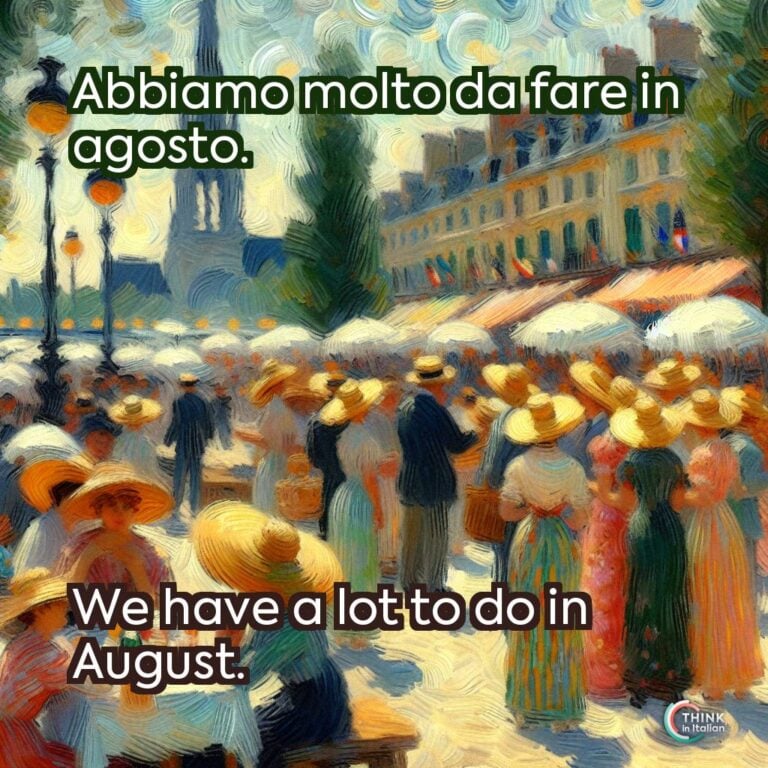Months and Seasons in Italian
Learning the names of the months and seasons in Italian is one of those simple but essential building blocks to improve your Italian. However, understanding their names is only the first step.
To fully grasp how to use months and seasons in Italian, you will need to learn the grammatical rules regarding capitalization, prepositions, and articles. This will also allow you to properly say the date in Italian.
Just like the days of the week, months and seasons in Italian come with their own linguistic history, often tied to Latin. Before diving into the grammar, let me show you their names and explore some interesting linguistic facts about how these terms came to be.
First, notice that the names of months in Italian, like in English, come from Latin and reflect the ancient Roman calendar system, with some months named after Roman gods, emperors, and numbers:
- Gennaio (January) comes from Ianuarius, named after Janus, the Roman god of doors and beginnings, symbolizing the start of the year.
- Febbraio (February) comes from Februarius, named after Februa, an ancient Roman purification festival.
- Marzo (March) is derived from Martius, named after Mars, the Roman god of war. It marked the beginning of the military campaign season in ancient Rome.
- Aprile (April) may come from Aperire, meaning “to open” symbolizing the blossoming of spring.
- Maggio (May) comes from Maius, possibly in honor of Maia, the Roman goddess of fertility and growth.
- Giugno (June) is named after Juno, the queen of the gods and goddess of marriage.
- Luglio (July), renamed in Julius Caesar’s honor.
- Agosto (August) is named after Emperor Augustus, Julius Caesar’s adopted son and the first Roman emperor.
- Settembre (September) comes from septem (seven). The name of the last four months reflect their original position in the Roman calendar, initially having only ten months, beginning in March and ending in December.
- Ottobre (October) comes from octo (eight).
- Novembre (November) comes from novem (nine).
- Dicembre (December) comes from decem (ten). What we now consider the ninth month of the year, September, was originally the seventh month, and so on for the others.
As for the seasons, the names also stem from Latin and have symbolic meanings associated with the cycle of nature:
- Primavera (Spring) reflects the beginning of new life, with prima meaning “first” and vera meaning “greenery”.
- Estate (Summer) comes from the Latin aestas, related to the heat of the season.
- Autunno (Autumn) derives from the Latin autumnus, marking the season of harvest.
- Inverno (Winter) comes from hibernum, related to cold and dormancy.
How to Use Months in Italian
Preposition “A” for Specific Months
When referring to something happening in a specific month, Italian uses the preposition a before the month’s name.
Vado in vacanza a luglio.
I’m going on vacation in July.
Ci vediamo a settembre.
See you in September.
No Definite Article for Specific Dates
When mentioning a specific date in a month, use the definite article il (the) before the date, but the month stands alone, without a preposition.
Il concerto è il 15 agosto.
The concert is on August 15th.
La festa è il 24 dicembre.
The party is on December 24th.
Prepositions for Time Ranges
To express time ranges that span multiple months, Italian uses da (from) and a (to), or fino a (until):
Lavoro da maggio a settembre.
I work from May to September.
Sarò in vacanza da giugno fino a ottobre.
I’ll be on vacation from June until October.
Not Capitalized
Unlike English, the months of the year in Italian are not capitalized, unless, of course, they are used at the beginning of a sentence.
How to Use Seasons in Italian
Preposition “In” for Seasons
When referring to something happening in a specific season, Italian uses the preposition in. This is similar to English:
In estate andiamo al mare.
In summer, we go to the beach.
Mi piace sciare in inverno.
I like skiing in the winter.
Prepositions for Time Ranges
Just like for months, when discussing actions that span multiple seasons, use da (from) and a (to), or fino a (until).
Sarò via da autunno fino a primavera.
I’ll be away from autumn until spring.
Be careful, though: if you want to generalize this time span, meaning something that occurs all years from a period to another, you have to use a definite article. Remember that prepositions must combine with definite articles.
Faccio un lavoro stagionale. Lavoro dalla primavera all’estate.
I have a seasonal job. I work from spring to summer.
Not Capitalized
Unlike English, the names of seasons in Italian are not capitalized, unless, of course, they are used at the beginning of a sentence.
A giugno sono andata in Sardegna.
I went to Sardinia in June.
Il suo compleanno è il 29 febbraio, che strano!
Her birthday is on the 29th of February, how odd!
Settembre è il mio mese preferito.
September is my favourite month.
Bonus Point
In Italian, just like in many other languages, we have a song to remember how many days there are in each month. Here it is:
Trenta giorni ha novembre,
con april(e), giugno e settembre,
di ventotto ce n’è uno,
tutti gli altri ne han trentuno.
Thirty days has November,
with April, June, and September,
there’s just one with twenty-eight,
all the rest have thirty-one.






